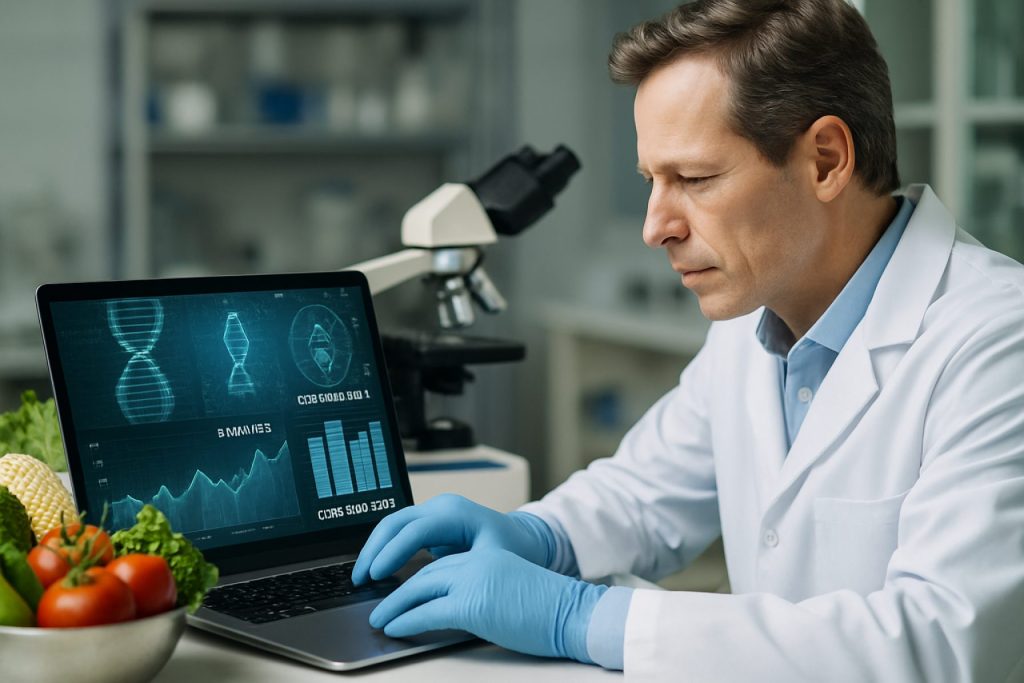
Agrifood Genomics Analytics Market Report 2025: Unveiling Data-Driven Innovations, Competitive Dynamics, and Global Growth Projections. Explore Key Trends, Regional Leaders, and Strategic Opportunities Shaping the Next Five Years.
- Executive Summary & Market Overview
- Key Technology Trends in Agrifood Genomics Analytics
- Competitive Landscape and Leading Players
- Market Size, Growth Forecasts, and CAGR Analysis (2025–2030)
- Regional Market Analysis: North America, Europe, APAC, and Rest of World
- Future Outlook: Emerging Applications and Investment Hotspots
- Challenges, Risks, and Strategic Opportunities
- Sources & References
Executive Summary & Market Overview
Agrifood genomics analytics refers to the application of advanced genomic sequencing, bioinformatics, and data analytics to improve agricultural and food production systems. By leveraging high-throughput sequencing technologies and sophisticated data analysis, stakeholders across the agrifood value chain can enhance crop yields, livestock productivity, disease resistance, and food quality. The global agrifood genomics analytics market is poised for robust growth in 2025, driven by increasing demand for sustainable agriculture, food security, and traceability solutions.
In 2025, the market is characterized by rapid adoption of next-generation sequencing (NGS) platforms, cloud-based analytics, and artificial intelligence (AI) tools. These technologies enable precise genotyping, trait mapping, and predictive breeding, which are critical for addressing climate change, resource constraints, and evolving consumer preferences. Major agribusinesses, seed companies, and food producers are investing heavily in genomics-driven R&D to accelerate the development of high-performing crop varieties and livestock breeds.
According to MarketsandMarkets, the global agrigenomics market is projected to reach USD 6.3 billion by 2025, growing at a CAGR of 9.7% from 2020. This growth is underpinned by increasing government initiatives for food safety, rising adoption of precision agriculture, and the need for efficient supply chain management. North America and Europe remain the leading regions, owing to strong research infrastructure and regulatory support, while Asia-Pacific is emerging as a high-growth market due to expanding agricultural biotechnology investments.
Key players such as Illumina, Thermo Fisher Scientific, and Eurofins Scientific are at the forefront, offering integrated genomics solutions tailored for agrifood applications. Strategic collaborations between technology providers, research institutes, and agrifood companies are accelerating innovation and commercialization of genomics analytics platforms.
Looking ahead to 2025, the agrifood genomics analytics market is expected to witness further integration of multi-omics data (genomics, transcriptomics, proteomics, and metabolomics), enhancing the precision and predictive power of analytics. Regulatory frameworks are also evolving to support the adoption of genomics in food safety, labeling, and traceability, further driving market expansion. Overall, agrifood genomics analytics is set to play a pivotal role in shaping the future of sustainable and resilient food systems worldwide.
Key Technology Trends in Agrifood Genomics Analytics
Agrifood genomics analytics is rapidly transforming the agricultural and food industries by leveraging advanced genomic technologies to enhance crop yields, improve livestock breeding, and ensure food safety. As we approach 2025, several key technology trends are shaping the evolution and adoption of agrifood genomics analytics, driven by the need for sustainable food production and precision agriculture.
- Integration of Artificial Intelligence and Machine Learning: AI and ML algorithms are increasingly being used to analyze complex genomic datasets, enabling faster identification of genetic markers linked to desirable traits in crops and livestock. These technologies facilitate predictive breeding and trait selection, significantly reducing the time and cost associated with traditional breeding methods. Companies such as Bayer and Corteva Agriscience are investing heavily in AI-driven genomics platforms to accelerate innovation.
- Advancements in Next-Generation Sequencing (NGS): The cost of NGS continues to decline, making high-throughput sequencing more accessible for agrifood applications. This enables large-scale genotyping, metagenomics, and transcriptomics studies, supporting the development of disease-resistant and climate-resilient crops. According to Illumina, the adoption of NGS in agriculture is expected to grow significantly through 2025, driven by demand for data-driven breeding programs.
- Cloud-Based Genomics Data Platforms: The proliferation of cloud computing is facilitating the storage, sharing, and analysis of massive genomic datasets. Cloud-based platforms enable real-time collaboration among researchers, breeders, and food producers, streamlining the translation of genomic insights into practical applications. Microsoft and Amazon Web Services are expanding their cloud offerings tailored to agrifood genomics analytics.
- CRISPR and Gene Editing Technologies: Precision gene editing tools such as CRISPR-Cas9 are being integrated with genomics analytics to develop crops and livestock with enhanced traits, such as improved nutritional content and resistance to pests. Regulatory advancements and public acceptance are expected to further drive the adoption of gene editing in agrifood sectors by 2025, as noted by Food and Agriculture Organization of the United Nations (FAO).
- Blockchain for Genomic Data Traceability: Blockchain technology is emerging as a solution for ensuring the integrity and traceability of genomic data across the agrifood supply chain. This trend supports transparency, regulatory compliance, and consumer trust, particularly in the context of genetically modified organisms (GMOs) and food safety, as highlighted by IBM Food Trust.
These technology trends are expected to accelerate the adoption and impact of agrifood genomics analytics in 2025, fostering innovation and sustainability across the global food system.
Competitive Landscape and Leading Players
The competitive landscape of the agrifood genomics analytics market in 2025 is characterized by a dynamic mix of established biotechnology firms, specialized genomics service providers, and emerging startups leveraging advanced data analytics and artificial intelligence. The sector is witnessing intensified competition as players race to offer more comprehensive, scalable, and cost-effective solutions for crop and livestock genomics, food safety, and traceability.
Leading players in this market include Illumina, Inc., which continues to dominate with its high-throughput sequencing platforms and robust bioinformatics tools tailored for agricultural genomics. Thermo Fisher Scientific Inc. remains a key competitor, offering a broad portfolio of genotyping and sequencing solutions, as well as cloud-based analytics for agrifood applications. Neogen Corporation has strengthened its position through strategic acquisitions and partnerships, focusing on genomics-based food safety and animal health analytics.
Emerging players such as Benson Hill and Inari Agriculture are disrupting the market by integrating proprietary genomics platforms with machine learning to accelerate crop trait discovery and breeding. These companies are attracting significant venture capital and forming collaborations with major agribusinesses to scale their analytics offerings.
The market is also seeing increased activity from data analytics and cloud computing firms, such as Google Cloud and Amazon Web Services (AWS), which provide scalable infrastructure for genomics data storage, processing, and analysis. Their entry is lowering barriers for smaller agrifood companies to adopt genomics analytics, intensifying competition and fostering innovation.
- Strategic Partnerships: Collaborations between genomics firms and agricultural producers are on the rise, aiming to co-develop analytics platforms tailored to specific crops, livestock, or supply chain needs.
- Geographic Expansion: Leading players are expanding their presence in emerging markets, particularly in Asia-Pacific and Latin America, to tap into growing demand for food security and sustainable agriculture solutions.
- Innovation Focus: Investment in AI-driven analytics, multi-omics integration, and real-time data platforms is a key differentiator among top competitors.
Overall, the agrifood genomics analytics market in 2025 is marked by rapid technological advancement, strategic consolidation, and a growing emphasis on end-to-end data solutions, with leading players setting the pace for innovation and market expansion.
Market Size, Growth Forecasts, and CAGR Analysis (2025–2030)
The global agrifood genomics analytics market is poised for robust expansion between 2025 and 2030, driven by the increasing adoption of genomics technologies in agriculture and food production. In 2025, the market is projected to reach a valuation of approximately USD 4.2 billion, with expectations to surpass USD 8.1 billion by 2030, reflecting a compound annual growth rate (CAGR) of around 13.8% during the forecast period MarketsandMarkets. This growth trajectory is underpinned by several converging factors, including the rising demand for sustainable food systems, the need for crop and livestock improvement, and the integration of advanced bioinformatics tools in genomics research.
Key market drivers include the increasing prevalence of next-generation sequencing (NGS) technologies, which have significantly reduced the cost and time required for genomic analysis. This has enabled broader adoption among agrifood companies, research institutions, and government agencies. Additionally, the growing focus on food safety, traceability, and authenticity is prompting stakeholders to invest in genomics-based analytics for pathogen detection, allergen identification, and supply chain transparency Grand View Research.
Regionally, North America is expected to maintain its dominance in the agrifood genomics analytics market through 2030, owing to strong government support, established research infrastructure, and the presence of leading genomics firms. However, Asia-Pacific is anticipated to witness the fastest CAGR, propelled by increasing investments in agricultural biotechnology, expanding food production, and supportive regulatory frameworks in countries such as China and India Fortune Business Insights.
- Crop Genomics: The segment is forecasted to account for the largest share, as seed companies and breeders leverage genomics analytics for trait selection, yield improvement, and disease resistance.
- Livestock Genomics: Growing at a steady pace, this segment benefits from the application of genomics in animal health, productivity, and breeding programs.
- Food Genomics: Increasingly important for food safety, authenticity testing, and allergen detection, this segment is expected to see accelerated adoption, particularly among food manufacturers and regulatory agencies.
Overall, the agrifood genomics analytics market is set for dynamic growth, with technological advancements, regulatory support, and industry collaborations shaping its evolution through 2030.
Regional Market Analysis: North America, Europe, APAC, and Rest of World
The global agrifood genomics analytics market is experiencing robust growth, with regional dynamics shaped by technological adoption, regulatory frameworks, and agricultural priorities. In 2025, North America, Europe, Asia-Pacific (APAC), and the Rest of the World (RoW) each present distinct opportunities and challenges for stakeholders in this sector.
North America remains the largest and most mature market for agrifood genomics analytics. The region benefits from advanced research infrastructure, significant investments in precision agriculture, and supportive government initiatives. The United States, in particular, leads in the integration of genomics for crop improvement, livestock breeding, and food safety testing. The presence of major players and collaborations between academic institutions and industry further accelerate innovation. According to Grand View Research, North America accounted for over 35% of the global market share in 2024, a trend expected to continue into 2025.
Europe is characterized by stringent regulatory standards and a strong focus on sustainability and traceability in the food supply chain. The European Union’s Common Agricultural Policy and investments in genomic research drive adoption, particularly in countries like Germany, France, and the Netherlands. The region’s emphasis on non-GMO solutions and biodiversity conservation shapes the application of genomics analytics. According to MarketsandMarkets, Europe is projected to witness a CAGR of over 10% through 2025, fueled by demand for transparent and sustainable food systems.
- APAC is the fastest-growing region, propelled by population growth, food security concerns, and government-led modernization of agriculture. China, India, and Japan are at the forefront, investing in genomics to enhance crop yields, disease resistance, and livestock productivity. The region’s diverse agro-ecological zones and rising adoption of digital agriculture tools create a fertile environment for genomics analytics. Fortune Business Insights reports that APAC’s market share is expected to surpass 25% by 2025.
- Rest of the World (RoW) includes Latin America, the Middle East, and Africa, where adoption is nascent but accelerating. Brazil and Argentina are notable for leveraging genomics in soybean and cattle industries, while African nations are exploring genomics to address food security and climate resilience. International collaborations and donor-funded projects are key drivers in these regions, as highlighted by OECD reports.
In summary, while North America and Europe lead in technological maturity and regulatory frameworks, APAC and RoW offer high-growth potential driven by demographic and agricultural transformation. Regional strategies tailored to local needs and regulatory landscapes will be critical for market success in 2025.
Future Outlook: Emerging Applications and Investment Hotspots
The future outlook for agrifood genomics analytics in 2025 is marked by rapid technological advancements, expanding applications, and a surge in investment activity. As the global food system faces mounting pressures from climate change, population growth, and sustainability demands, genomics analytics is emerging as a transformative tool across the agrifood value chain.
Emerging applications are particularly prominent in precision breeding, crop resilience, and livestock health. Genomic selection is enabling breeders to accelerate the development of high-yield, climate-resilient crop varieties and disease-resistant livestock. For instance, the integration of next-generation sequencing (NGS) and machine learning is allowing for the identification of complex genetic traits, which can be leveraged to improve productivity and nutritional quality in staple crops such as wheat, rice, and maize. Companies like Bayer and Corteva Agriscience are investing heavily in these technologies to maintain competitive advantage and address food security challenges.
Another key area of growth is in food safety and traceability. Genomics analytics is being deployed to detect pathogens, verify food authenticity, and monitor supply chains in real time. This is particularly relevant as regulatory frameworks tighten and consumer demand for transparency increases. Organizations such as Eurofins Scientific are expanding their genomics-based testing services to meet these needs, while startups are innovating with blockchain-genomics integrations for end-to-end traceability.
Investment hotspots are shifting towards regions with strong agri-biotech ecosystems and supportive policy environments. North America remains a leader, but significant growth is anticipated in Asia-Pacific, driven by government initiatives in China and India to modernize agriculture through genomics. According to Grand View Research, the global agricultural genomics market is projected to reach over $17 billion by 2025, with double-digit CAGR fueled by both public and private sector funding.
- Precision breeding and trait discovery
- Livestock genomics for disease resistance
- Food safety, authenticity, and traceability
- Microbiome analytics for soil and plant health
- Digital platforms integrating genomics with AI and IoT
In summary, 2025 will see agrifood genomics analytics at the forefront of agricultural innovation, with expanding applications and robust investment shaping a more resilient and transparent food system.
Challenges, Risks, and Strategic Opportunities
The agrifood genomics analytics sector in 2025 faces a complex landscape of challenges, risks, and strategic opportunities as it seeks to transform global food systems. One of the primary challenges is the integration and standardization of vast, heterogeneous genomic datasets across crops, livestock, and aquaculture. Disparate data formats, inconsistent metadata, and varying quality control protocols hinder interoperability and slow the pace of innovation. This is compounded by the need for robust bioinformatics infrastructure and skilled personnel, which remain in short supply, particularly in emerging markets (Food and Agriculture Organization of the United Nations).
Data privacy and intellectual property (IP) risks are also significant. As genomic data becomes a critical asset, concerns over data ownership, cross-border data flows, and the potential misuse of proprietary genetic information intensify. Regulatory frameworks are evolving, but inconsistencies between regions—such as the EU’s General Data Protection Regulation (GDPR) versus more permissive regimes—create compliance complexities for multinational agrifood companies (Organisation for Economic Co-operation and Development).
Another risk is the potential for public resistance to genomics-driven food products, especially those involving gene editing or synthetic biology. Consumer skepticism, fueled by misinformation and lack of transparency, can delay market adoption and trigger regulatory scrutiny. Companies must invest in clear communication and traceability solutions to build trust and demonstrate the benefits of genomics-enabled agriculture (International Food Policy Research Institute).
Despite these challenges, strategic opportunities abound. Advances in AI-powered analytics and cloud computing are enabling more rapid, cost-effective genomic data processing and interpretation. This opens the door for precision breeding, disease resistance, and yield optimization at unprecedented scales. Strategic partnerships between agritech firms, research institutions, and governments are accelerating the development of open-source genomic databases and shared analytics platforms, fostering innovation and reducing duplication of effort (Corteva Agriscience).
- Expansion into emerging markets, where food security is a priority, offers significant growth potential for genomics analytics providers.
- Integration with digital agriculture tools (e.g., IoT sensors, remote sensing) can create holistic, data-driven farm management solutions.
- Regenerative agriculture and sustainability initiatives are driving demand for genomics analytics to optimize resource use and reduce environmental impact.
In summary, while the agrifood genomics analytics sector in 2025 must navigate technical, regulatory, and societal hurdles, it is also positioned to unlock transformative value through strategic innovation and cross-sector collaboration.
Sources & References
- MarketsandMarkets
- Illumina
- Thermo Fisher Scientific
- Corteva Agriscience
- Microsoft
- Amazon Web Services
- Food and Agriculture Organization of the United Nations (FAO)
- IBM Food Trust
- Neogen Corporation
- Benson Hill
- Google Cloud
- Grand View Research
- Fortune Business Insights
- International Food Policy Research Institute



